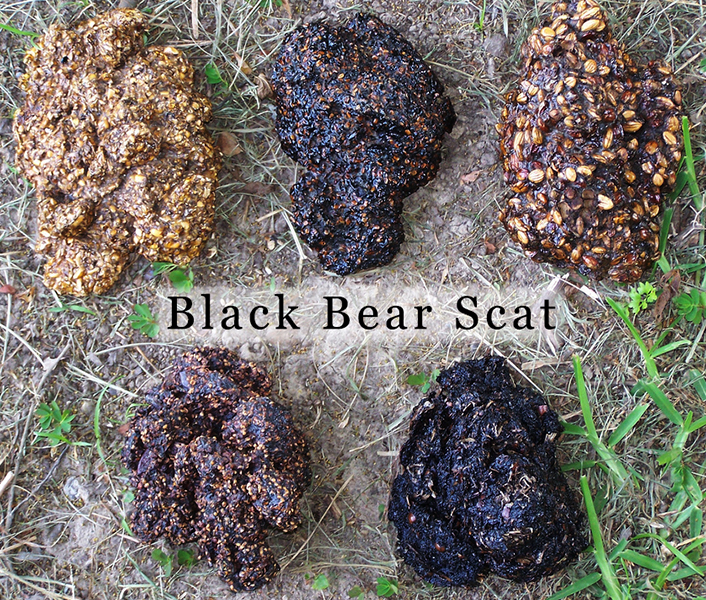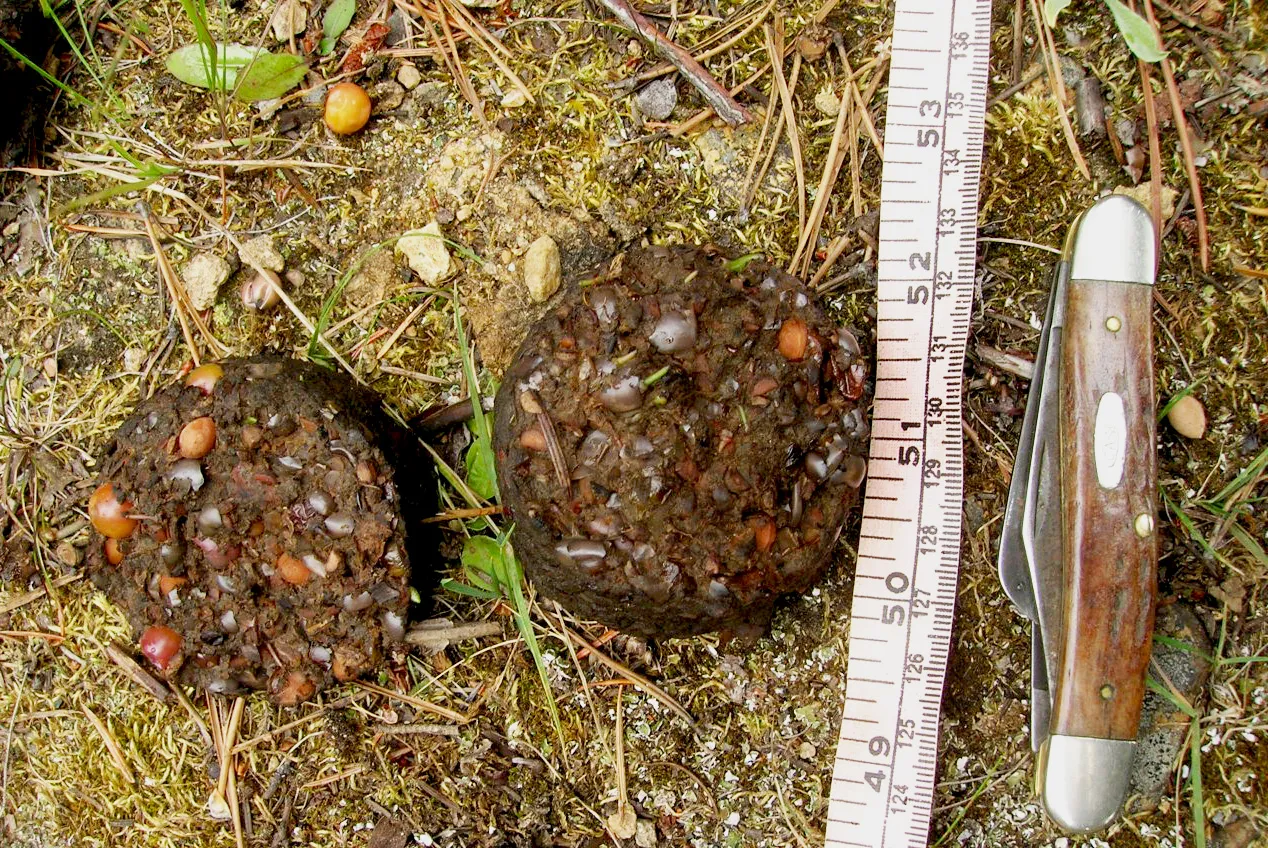Jan 01, 1970
0 years old
What does bear scat look like? Bear scat is typically large, tubular, and often tapered at the ends, with a size and content that vary depending on the bear’s diet.
In forests or hiking trails, it can range from 4 to 8 inches long and 1–2 inches wide, sometimes containing berries, seeds, plant matter, or even hair and bone fragments.
The color and consistency change with what the bear has eaten recently—plant-based diets produce softer, darker scat, while carnivorous meals leave firmer droppings. Identifying bear scat is important for hikers and wildlife enthusiasts to recognize bear activity, stay safe, and avoid surprising a bear in its natural habitat.

Bear scat refers to the fecal matter left behind by bears in the wild. Identifying this type of scat provides critical clues about the bear’s diet, health, and activity patterns.
Unlike many animals, bears are omnivores, meaning their feces can vary widely based on what they’ve been eating—from berries and seeds to small mammals and insect parts.
Knowing where and how to find bear poop can help hikers and campers recognize when they are in bear country, increasing safety by avoiding unwanted bear encounters.
Further, it offers wildlife enthusiasts and researchers a non-invasive way to study bears over an extended period by interpreting the scat’s contents and condition.
Black bear scat is distinct compared to the droppings of many other wild animals like moose or elk, although initial identification can sometimes be tricky. Black bear poop often has a tubular shape with segments and can range from a couple of inches long to over 10 inches, depending on the food consumed.
In contrast, moose scat typically appears as small, dark pellets or “pellets,” which can easily be distinguished from the tubular and often more voluminous bear poop. The presence of visible seeds and berry skins in bear feces also helps differentiate it from more fibrous and plant-heavy moose scat.
Bear scat is one of the most useful signs for understanding bear activity and presence in the wild. Observing it can provide insight into a bear’s diet, behavior, and the areas it frequents, making it an essential skill for hikers, campers, and wildlife enthusiasts.
The contents of bear scat reveal a lot about its recent meals. Plant matter, berries, nuts, and seeds are common in summer and fall, while hair, bones, or insect remains may appear when bears consume small mammals or insects.
Observing scat composition can help track bear diet patterns, seasonal habits, and even determine whether the bear is primarily herbivorous or has included meat in its diet.
Bear scat is often found along trails, near streams, on berry patches, or near overturned logs and rocks where bears forage. Fresh scat indicates recent activity, so hikers should remain cautious and make noise to avoid surprising a bear. Bears also deposit scat in prominent locations as a territorial marker, helping them communicate with other bears.
If you come across bear scat in the wild, do not touch it. Stay alert, make your presence known, and maintain a safe distance. Use scat observations as a tool to enjoy wildlife responsibly without disturbing the animal.

While both black bears and grizzly bears defecate tubular scat, there are subtle differences. The grizzly bear scat tends to be larger and often contains more fibrous material due to a diet that includes roots and tougher plant stems.
The shape may be more irregular, and the stool might appear coarser and less segmented. Grizzly bear poop is generally easier to spot due to its dark brown to black color and size, often measuring larger in diameter than black bear scat. Bears leave scat not just as waste but also as signals—grizzlies frequently defecate on trails or open areas to mark their territory.
The appearance of bear scat varies significantly throughout the year because bears’ diets shift with the seasons. During spring, the stool may be loose and filled with vegetation and insect remains as bears graze on new plant shoots.
In summer and fall, as bears consume more berries and nuts, the poop darkens and becomes moister and full of seeds. Towards winter, when bears prey more on small mammals or scavenge, the feces may be firmer and contain more animal material.
These poop changes closely reflect the bear has been eating, helping trackers determine the time of year and the bear’s behavior.
Bear poop is typically found along trails, near water sources, or beneath berry patches. Bears often defecate in easily visible areas where they travel or forage to mark their territory. Because scat is easy to spot due to its size and frequent presence, it serves as a useful indicator that bears are in the area.
Pay particular attention to places with abundant food sources; in bear country, it’s common to find bear scat along game trails used by moose and elk as well, so careful identification is crucial.
Because of overlapping habitats, animal scat from moose, elk, and deer can sometimes be confused with bear poop. However, moose scat appears as numerous small, round pellets, unlike the tubular, segmented bear scat.
Elk scat is similarly pellet-like but often larger and more oval-shaped. The consistency and contents also differ, as moose and elk are herbivores with a ruminant digestive system, resulting in fibrous, pelletized feces, whereas bear scat varies greatly due to their omnivorous habits. Being familiar with these differences helps prevent misidentification while exploring wildlife areas.
The shape and consistency of bear scat depend largely on the bear’s recent diet and hydration status. When a bear is eating a primarily plant-based diet filled with fibrous vegetation, the scat will be more solid and tubular.
If the bear is feeding heavily on berries or moist foods, the scat becomes looser and may resemble a softer stool with visible seeds. Sometimes the scat is segmented into parts, similar to the shape of human feces but generally larger. The diameter can be about an inch or greater, often making it easy to spot on the forest floor.
Bears leave scat primarily as a consequence of digestion, but they also use feces as a communication tool to mark their territory. By defecating in prominent locations such as trails and open clearings, bears can signal their presence to others, which helps reduce direct confrontations.
The chemical makeup of the feces, including the microorganisms present, conveys information about the bear’s identity and reproductive status. Thus, scat serves as a natural signpost within their habitat, offering clues not only for humans but for other animals as well.

How do you identify bear poop?
Bear scat is usually large (4–8 inches long), tubular, and tapered at the ends. Its content varies with diet: berries, seeds, and plant matter make it softer, while carnivorous diets leave hair and bone fragments.
What does a coyote scat look like?
Coyote scat is smaller (1–2 inches wide, 4–10 inches long), tubular, often twisted, and may contain fur, bones, or seeds. It’s usually deposited in prominent areas to mark territory.
Is scat the same as poop?
Yes. Scat is the scientific or wildlife term for feces, while poop is the everyday word.
Does bear scat stink?
Yes, bear scat can have a strong odor, especially when it contains decaying meat or fish. Plant-based scat has a milder smell.
What to do if you find bear poop?
Do not touch it. Note the location, move away carefully, and be alert. Bears may be nearby, and the area can be dangerous.
How to tell if a bear is near?
Signs include fresh scat, tracks, overturned rocks/logs, claw marks on trees, or torn vegetation. Always make noise when hiking in bear country to avoid surprising one.
How to identify wildlife poo?
Look at size, shape, content, location, and smell. Compare with field guides for species in your area. Observing patterns like territorial marking can help identify the animal.
Bear scat varies widely in appearance depending on the bear’s diet and season.
Black bear scat is typically tubular with segments, dark brown to black in color, and often filled with berries and seeds.
Grizzly bear scat is generally larger, coarser, and contains more fibrous plant matter.
Seasonal changes influence the moisture, size, and content of the poop.
Bears often defecate in visible locations to mark territory and signal their presence.
Bear poop differs significantly from moose scat and elk pellets, which are small, round, and dry.
Distinguishing bear poop helps improve safety and understanding of wildlife behavior.
Bear scat is an excellent non-invasive resource for studying bears and their ecology.
Scat contents, such as insect parts, small mammal bones, and plant seeds, reveal what the bear has been eating.
Knowing how and where to find bear scat is essential for anyone exploring bear country.
With these facts about bear scat, you are now better equipped to identify animal droppings, learn from nature, and stay safe while enjoying the great outdoors.
In conclusion, bear scat varies in size, shape, and content depending on the bear’s diet and age. Typically, it is large, tubular, and sometimes tapered at the ends, with plant matter, berries, seeds, or hair depending on what the bear has been eating.
Observing bear scat can provide valuable information about bear activity, diet, and presence in a particular area, making it an important skill for hikers, wildlife enthusiasts, and researchers.
Always remember to maintain a safe distance, as fresh scat indicates a bear may be nearby. Understanding the characteristics of bear scat not only helps with identification but also promotes safety and awareness while enjoying wildlife habitats.
